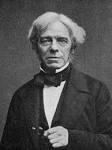| Date | Text | |
|---|---|---|
29 Aug 1831

Faraday experiment |
Faraday experiment In 1831, Michael Faraday wound a thick iron ring on one side with insulated wire that was connected to a battery. He then wound the opposite side with wire connected to a galvanometer. He found that upon closing the battery circuit, there was a deflection of the galvanometer in the second circuit. Then he was astonished to see the galvanometer needle jump in the opposite direction when the battery circuit was opened. He had discovered that a current was induced in the secondary when a current in the primary was connected and an induced current in the opposite direction when the primary current was disconnected. |
|
29 Aug 1831

Darwin invited as Beagle naturalist |
Darwin invited as Beagle naturalist In 1831, Charles Darwin returned home from a geology field trip in North Wales to find letters from Revd. John Henslow and George Peacock informing him that he will soon be invited on a scientific voyage of HMS Beagle. He was 22 years old, and had just graduated from Cambridge University. The offer was to be a naturalist on H.M.S. Beagle for a two year survey of South America, leaving on 25 Sep. Although he immediately accepted the offer, his father and sisters were opposed. They regarded it as an idle pursuit that would delay his expected career in the clergy. His father, however, was prepared to change his mind, but only if Darwin could find a qualified man who viewed the exploit as worthwhile. Darwin spent the next two days doing just that. |
|
29 Aug 1831

Michael Faraday |
Michael Faraday (technology) Michael Faraday demonstrates electromagnetic induction at the Royal Society.Joseph Henry recognises it at about the same time. Faraday also develops the Faraday Wheel, a homopolar generator. |